Abstract
BACKGROUND: Under normal conditions, there are no torsional eye movements during voluntary saccades when the head is stationary (Listing's law). METHODS AND RESULTS: Using dual search coils for three dimensional eye movement recordings, a patient is reported who had direction specific rapid deviations of torsional eye position (up to 10.5 degrees) during voluntary saccades followed by a slow exponential torsional drift after the end of the saccade ("blip") towards the initial torsional eye position. In the absence of spontaneous nystagmus, this transient torsion means a violation of Listing's law for voluntary saccades and was associated with a lesion involving the cerebellar vermis, its deep nuclei, and the dorsolateral medulla. Amplitudes of the blip were larger for ipsilesional (hypermetric) than contralesional (hypometric) horizontal saccades. For comparison transient torsion during and after saccades was also examined in six normal subjects. Using the same in vivo calibration, there were no blips larger than 1.2 degrees in any of them. CONCLUSION: Transient torsion with large amplitudes can be clinically seen on bedside examination and might thus be a new clinical sign in the diagnosis of saccadic disorders.
Full text
PDF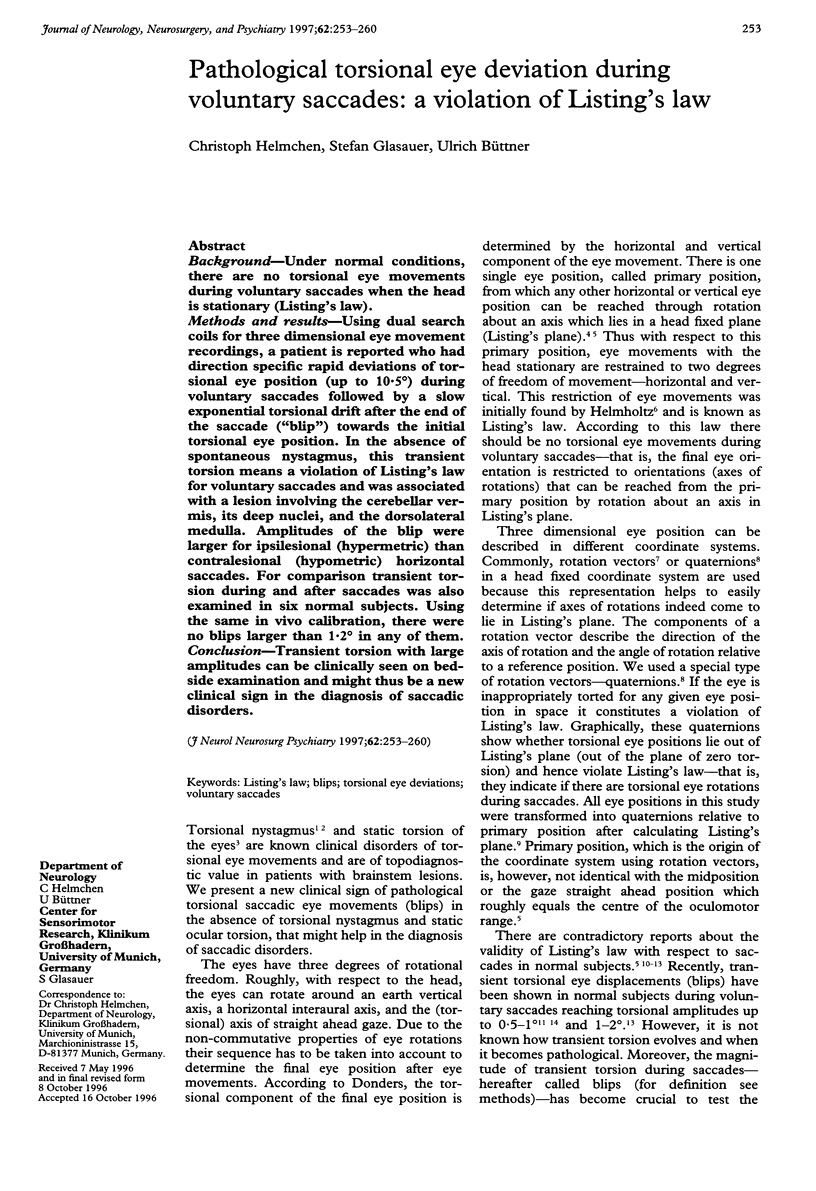
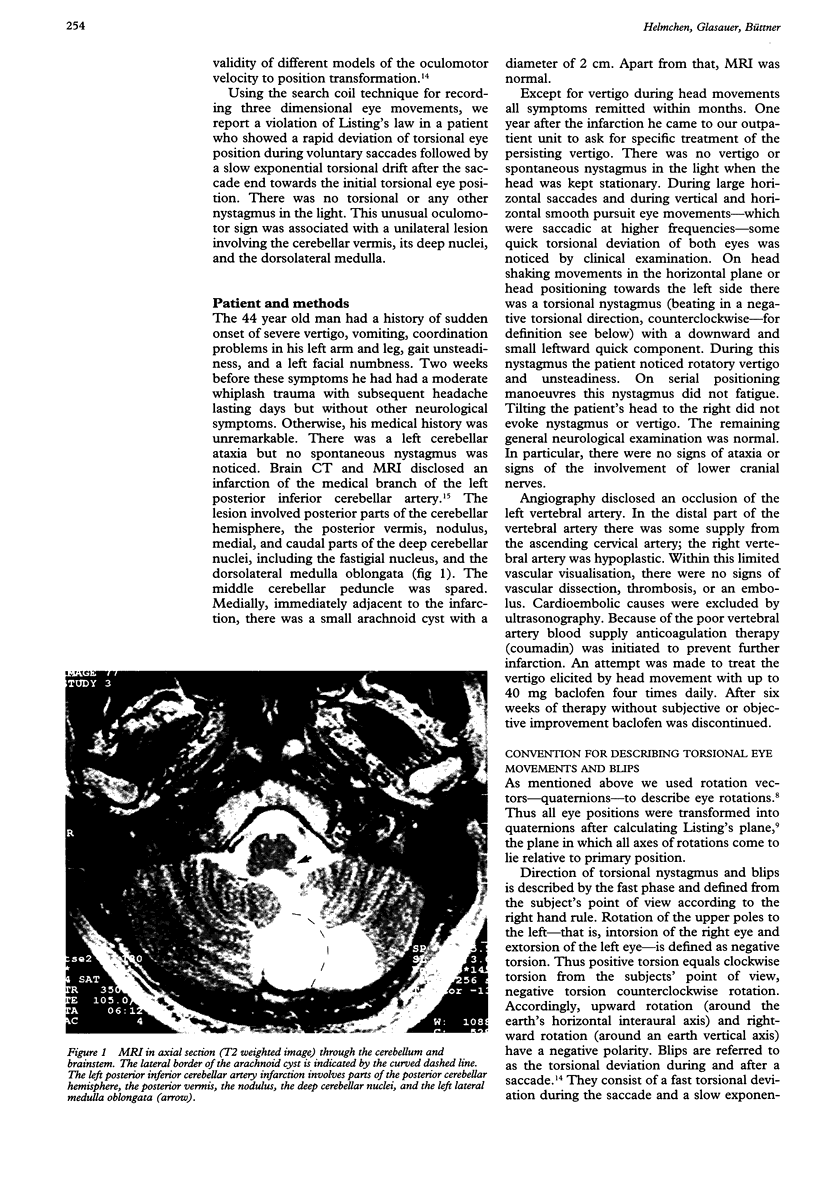
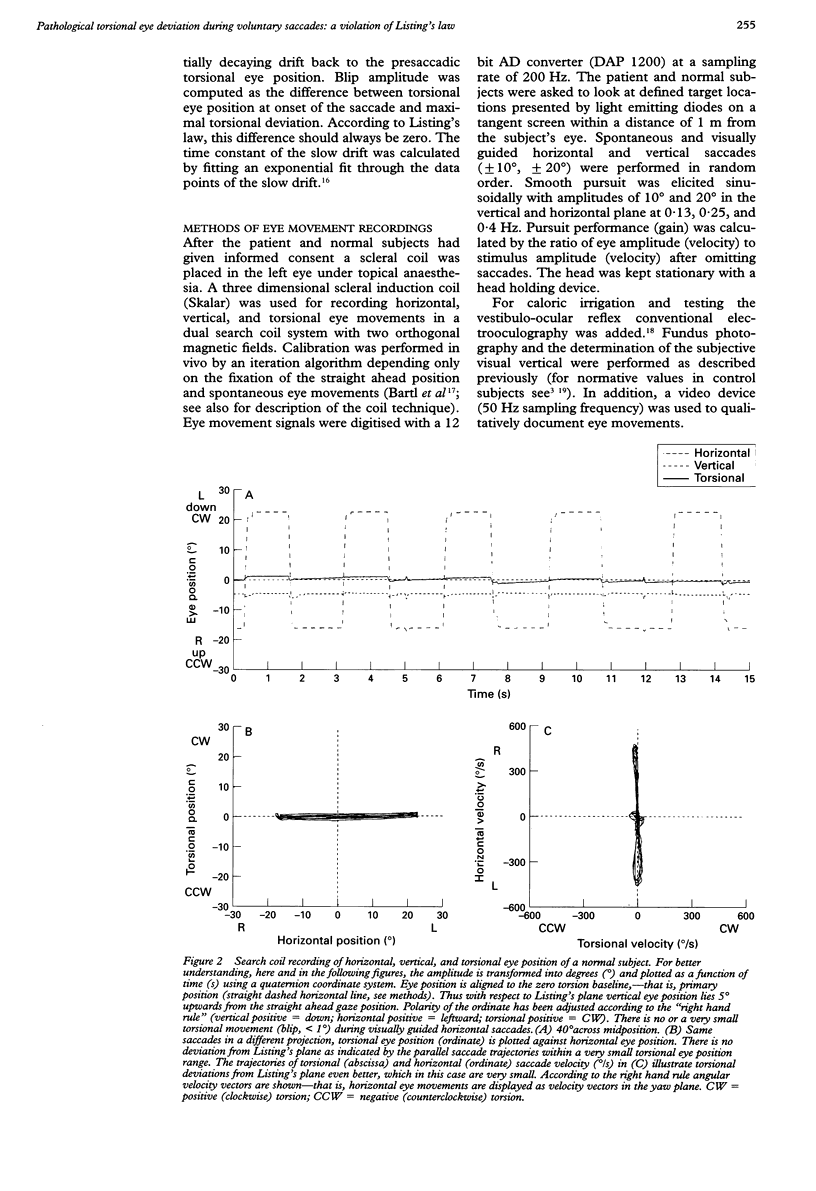
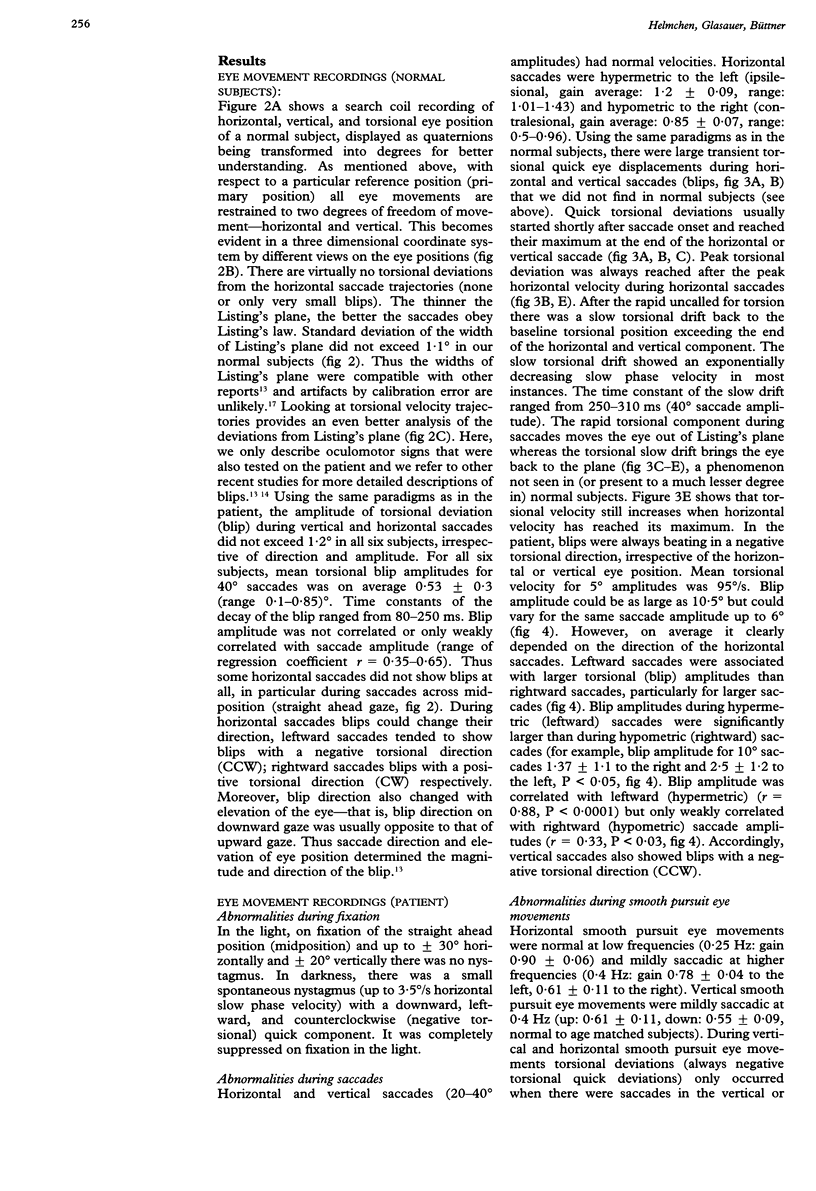
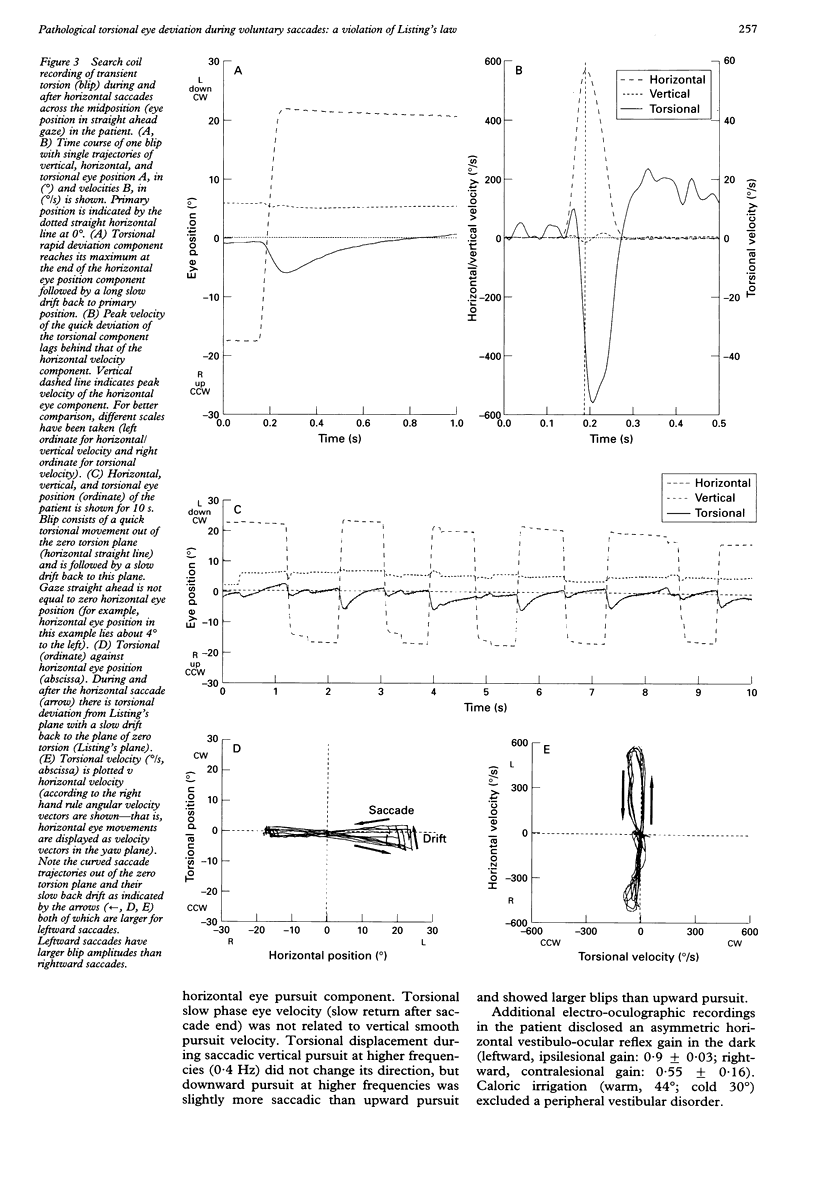
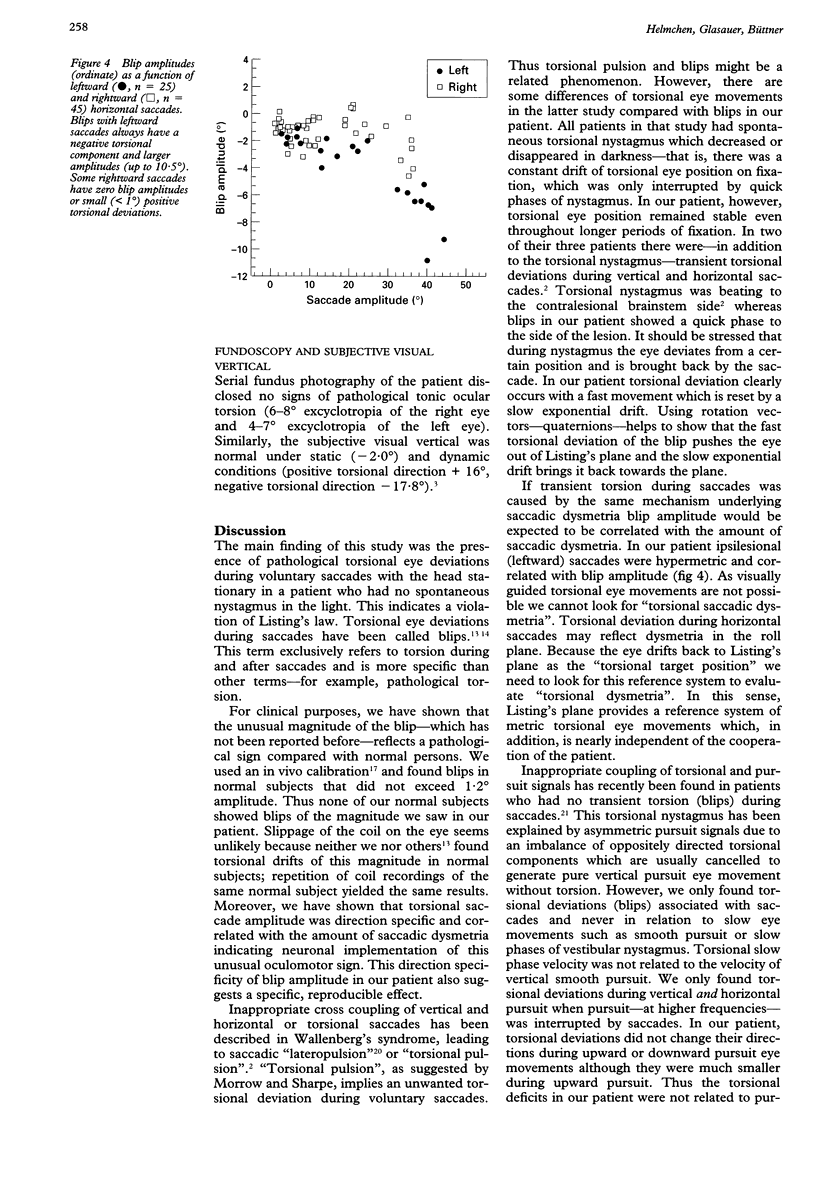
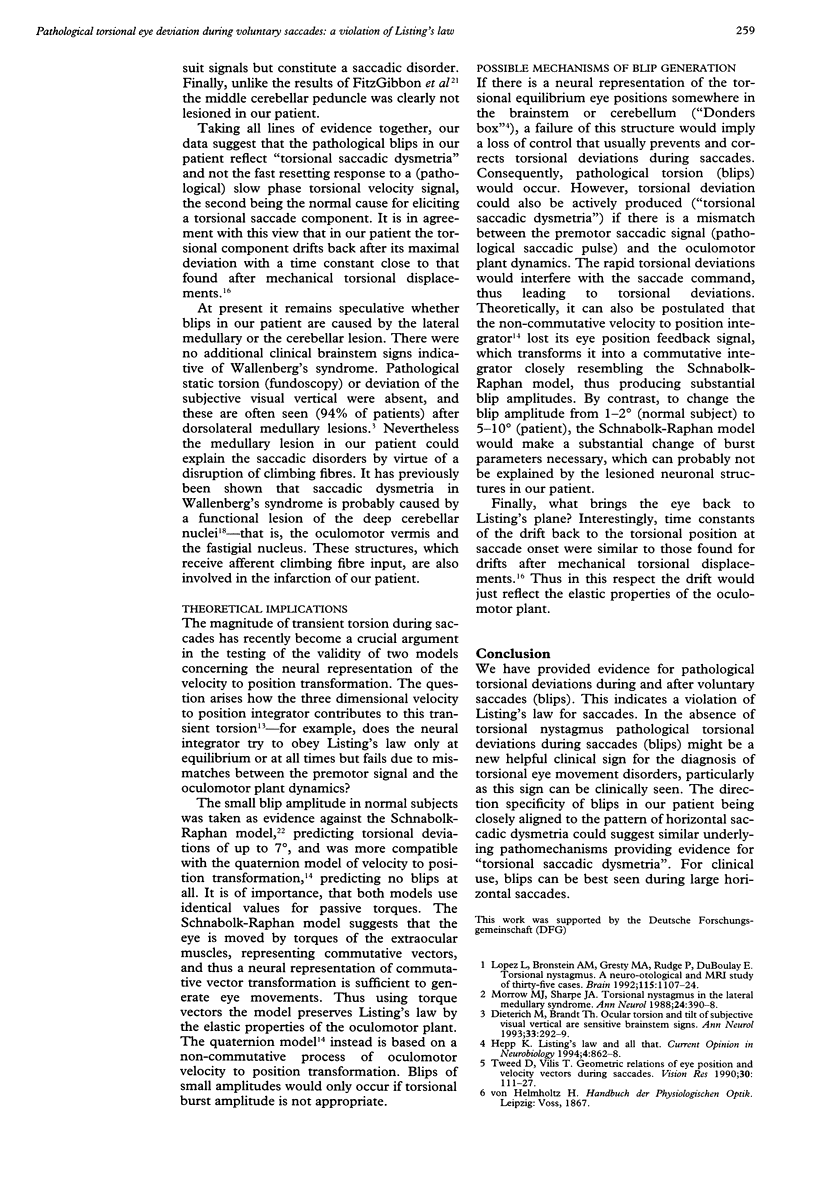
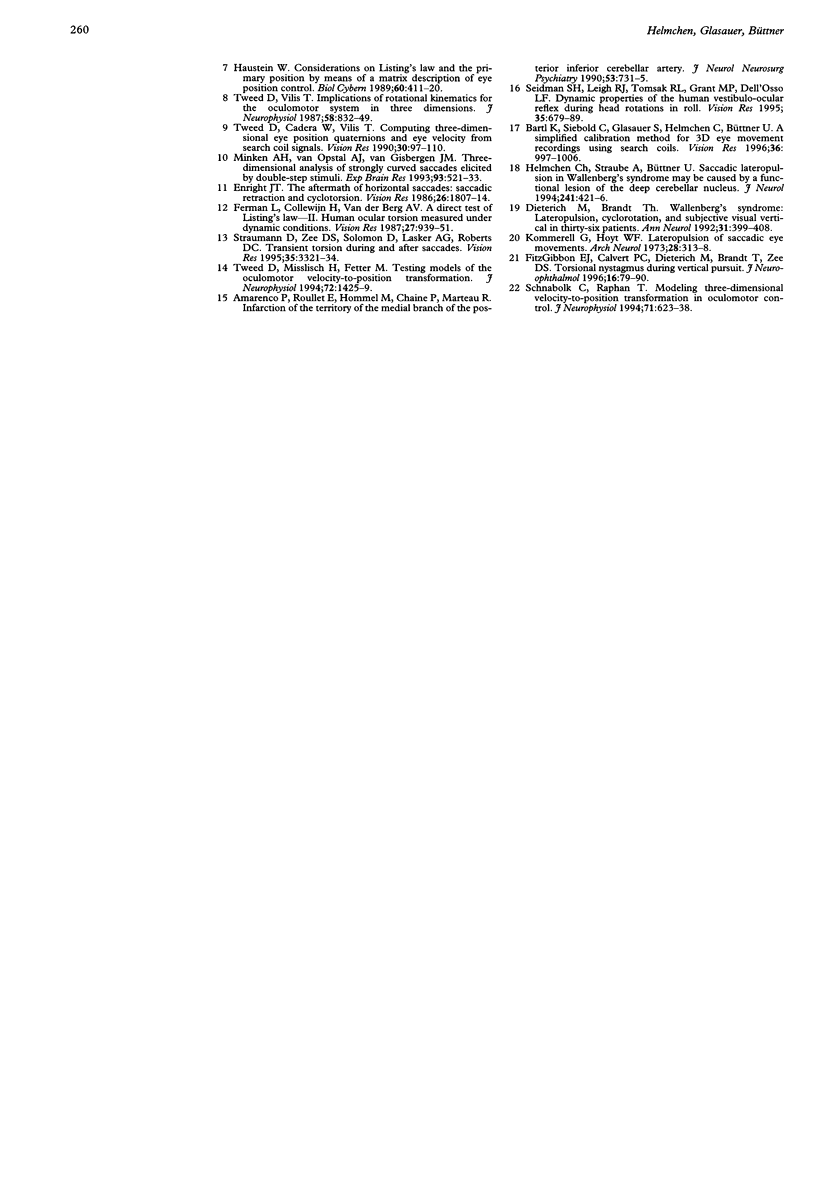
Images in this article
Selected References
These references are in PubMed. This may not be the complete list of references from this article.
- Amarenco P., Roullet E., Hommel M., Chaine P., Marteau R. Infarction in the territory of the medial branch of the posterior inferior cerebellar artery. J Neurol Neurosurg Psychiatry. 1990 Sep;53(9):731–735. doi: 10.1136/jnnp.53.9.731. [DOI] [PMC free article] [PubMed] [Google Scholar]
- Bartl K., Siebold C., Glasauer S., Helmchen C., Büttner U. A simplified calibration method for three-dimensional eye movement recordings using search-coils. Vision Res. 1996 Apr;36(7):997–1006. doi: 10.1016/0042-6989(95)00201-4. [DOI] [PubMed] [Google Scholar]
- Dieterich M., Brandt T. Ocular torsion and tilt of subjective visual vertical are sensitive brainstem signs. Ann Neurol. 1993 Mar;33(3):292–299. doi: 10.1002/ana.410330311. [DOI] [PubMed] [Google Scholar]
- Dieterich M., Brandt T. Wallenberg's syndrome: lateropulsion, cyclorotation, and subjective visual vertical in thirty-six patients. Ann Neurol. 1992 Apr;31(4):399–408. doi: 10.1002/ana.410310409. [DOI] [PubMed] [Google Scholar]
- Enright J. T. The aftermath of horizontal saccades: saccadic retraction and cyclotorsion. Vision Res. 1986;26(11):1807–1814. doi: 10.1016/0042-6989(86)90132-x. [DOI] [PubMed] [Google Scholar]
- Ferman L., Collewijn H., Van den Berg A. V. A direct test of Listing's law--II. Human ocular torsion measured under dynamic conditions. Vision Res. 1987;27(6):939–951. doi: 10.1016/0042-6989(87)90010-1. [DOI] [PubMed] [Google Scholar]
- FitzGibbon E. J., Calvert P. C., Dieterich M., Brandt T., Zee D. S. Torsional nystagmus during vertical pursuit. J Neuroophthalmol. 1996 Jun;16(2):79–90. [PubMed] [Google Scholar]
- Haustein W. Considerations on Listing's Law and the primary position by means of a matrix description of eye position control. Biol Cybern. 1989;60(6):411–420. doi: 10.1007/BF00204696. [DOI] [PubMed] [Google Scholar]
- Helmchen C., Straube A., Büttner U. Saccadic lateropulsion in Wallenberg's syndrome may be caused by a functional lesion of the fastigial nucleus. J Neurol. 1994 Jun;241(7):421–426. doi: 10.1007/BF00900959. [DOI] [PubMed] [Google Scholar]
- Hepp K. Oculomotor control: Listing's law and all that. Curr Opin Neurobiol. 1994 Dec;4(6):862–868. doi: 10.1016/0959-4388(94)90135-x. [DOI] [PubMed] [Google Scholar]
- Kommerell G., Hoyt W. F. Lateropulsion of saccadic eye movements. Electro-oculographic studies in a patient with Wallenberg's syndrome. Arch Neurol. 1973 May;28(5):313–318. doi: 10.1001/archneur.1973.00490230049006. [DOI] [PubMed] [Google Scholar]
- Lopez L., Bronstein A. M., Gresty M. A., Rudge P., du Boulay E. P. Torsional nystagmus. A neuro-otological and MRI study of thirty-five cases. Brain. 1992 Aug;115(Pt 4):1107–1124. doi: 10.1093/brain/115.4.1107. [DOI] [PubMed] [Google Scholar]
- Minken A. W., Van Opstal A. J., Van Gisbergen J. A. Three-dimensional analysis of strongly curved saccades elicited by double-step stimuli. Exp Brain Res. 1993;93(3):521–533. doi: 10.1007/BF00229367. [DOI] [PubMed] [Google Scholar]
- Morrow M. J., Sharpe J. A. Torsional nystagmus in the lateral medullary syndrome. Ann Neurol. 1988 Sep;24(3):390–398. doi: 10.1002/ana.410240307. [DOI] [PubMed] [Google Scholar]
- Schnabolk C., Raphan T. Modeling three-dimensional velocity-to-position transformation in oculomotor control. J Neurophysiol. 1994 Feb;71(2):623–638. doi: 10.1152/jn.1994.71.2.623. [DOI] [PubMed] [Google Scholar]
- Seidman S. H., Leigh R. J., Tomsak R. L., Grant M. P., Dell'Osso L. F. Dynamic properties of the human vestibulo-ocular reflex during head rotations in roll. Vision Res. 1995 Mar;35(5):679–689. doi: 10.1016/0042-6989(94)00151-b. [DOI] [PubMed] [Google Scholar]
- Straumann D., Zee D. S., Solomon D., Lasker A. G., Roberts D. C. Transient torsion during and after saccades. Vision Res. 1995 Dec;35(23-24):3321–3334. doi: 10.1016/0042-6989(95)00091-r. [DOI] [PubMed] [Google Scholar]
- Tweed D., Cadera W., Vilis T. Computing three-dimensional eye position quaternions and eye velocity from search coil signals. Vision Res. 1990;30(1):97–110. doi: 10.1016/0042-6989(90)90130-d. [DOI] [PubMed] [Google Scholar]
- Tweed D., Misslisch H., Fetter M. Testing models of the oculomotor velocity-to-position transformation. J Neurophysiol. 1994 Sep;72(3):1425–1429. doi: 10.1152/jn.1994.72.3.1425. [DOI] [PubMed] [Google Scholar]
- Tweed D., Vilis T. Geometric relations of eye position and velocity vectors during saccades. Vision Res. 1990;30(1):111–127. doi: 10.1016/0042-6989(90)90131-4. [DOI] [PubMed] [Google Scholar]
- Tweed D., Vilis T. Implications of rotational kinematics for the oculomotor system in three dimensions. J Neurophysiol. 1987 Oct;58(4):832–849. doi: 10.1152/jn.1987.58.4.832. [DOI] [PubMed] [Google Scholar]



